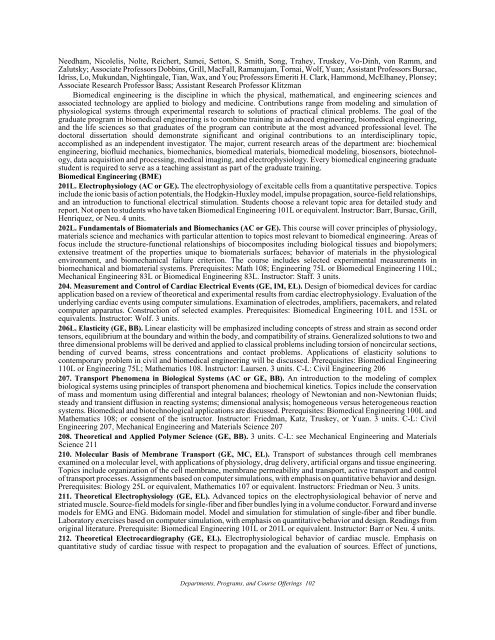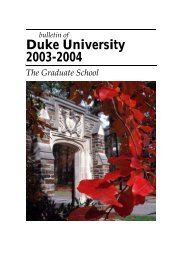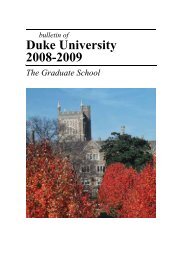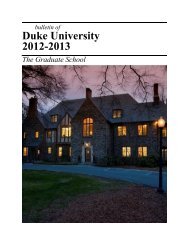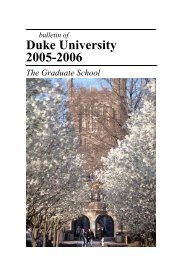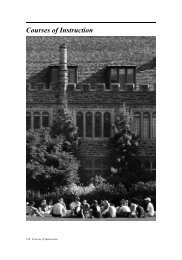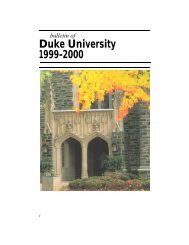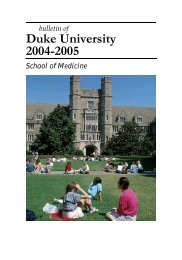Duke University 2009-2010 - Office of the Registrar - Duke University
Duke University 2009-2010 - Office of the Registrar - Duke University
Duke University 2009-2010 - Office of the Registrar - Duke University
You also want an ePaper? Increase the reach of your titles
YUMPU automatically turns print PDFs into web optimized ePapers that Google loves.
Needham, Nicolelis, Nolte, Reichert, Samei, Setton, S. Smith, Song, Trahey, Truskey, Vo-Dinh, von Ramm, and<br />
Zalutsky; Associate Pr<strong>of</strong>essors Dobbins, Grill, MacFall, Ramanujam, Tornai, Wolf, Yuan; Assistant Pr<strong>of</strong>essors Bursac,<br />
Idriss, Lo, Mukundan, Nightingale, Tian, Wax, and You; Pr<strong>of</strong>essors Emeriti H. Clark, Hammond, McElhaney, Plonsey;<br />
Associate Research Pr<strong>of</strong>essor Bass; Assistant Research Pr<strong>of</strong>essor Klitzman<br />
Biomedical engineering is <strong>the</strong> discipline in which <strong>the</strong> physical, ma<strong>the</strong>matical, and engineering sciences and<br />
associated technology are applied to biology and medicine. Contributions range from modeling and simulation <strong>of</strong><br />
physiological systems through experimental research to solutions <strong>of</strong> practical clinical problems. The goal <strong>of</strong> <strong>the</strong><br />
graduate program in biomedical engineering is to combine training in advanced engineering, biomedical engineering,<br />
and <strong>the</strong> life sciences so that graduates <strong>of</strong> <strong>the</strong> program can contribute at <strong>the</strong> most advanced pr<strong>of</strong>essional level. The<br />
doctoral dissertation should demonstrate significant and original contributions to an interdisciplinary topic,<br />
accomplished as an independent investigator. The major, current research areas <strong>of</strong> <strong>the</strong> department are: biochemical<br />
engineering, bi<strong>of</strong>luid mechanics, biomechanics, biomedical materials, biomedical modeling, biosensors, biotechnology,<br />
data acquisition and processing, medical imaging, and electrophysiology. Every biomedical engineering graduate<br />
student is required to serve as a teaching assistant as part <strong>of</strong> <strong>the</strong> graduate training.<br />
Biomedical Engineering (BME)<br />
201L. Electrophysiology (AC or GE). The electrophysiology <strong>of</strong> excitable cells from a quantitative perspective. Topics<br />
include <strong>the</strong> ionic basis <strong>of</strong> action potentials, <strong>the</strong> Hodgkin-Huxley model, impulse propagation, source-field relationships,<br />
and an introduction to functional electrical stimulation. Students choose a relevant topic area for detailed study and<br />
report. Not open to students who have taken Biomedical Engineering 101L or equivalent. Instructor: Barr, Bursac, Grill,<br />
Henriquez, or Neu. 4 units.<br />
202L. Fundamentals <strong>of</strong> Biomaterials and Biomechanics (AC or GE). This course will cover principles <strong>of</strong> physiology,<br />
materials science and mechanics with particular attention to topics most relevant to biomedical engineering. Areas <strong>of</strong><br />
focus include <strong>the</strong> structure-functional relationships <strong>of</strong> biocomposites including biological tissues and biopolymers;<br />
extensive treatment <strong>of</strong> <strong>the</strong> properties unique to biomaterials surfaces; behavior <strong>of</strong> materials in <strong>the</strong> physiological<br />
environment, and biomechanical failure criterion. The course includes selected experimental measurements in<br />
biomechanical and biomaterial systems. Prerequisites: Math 108; Engineering 75L or Biomedical Engineering 110L;<br />
Mechanical Engineering 83L or Biomedical Engineering 83L. Instructor: Staff. 3 units.<br />
204. Measurement and Control <strong>of</strong> Cardiac Electrical Events (GE, IM, EL). Design <strong>of</strong> biomedical devices for cardiac<br />
application based on a review <strong>of</strong> <strong>the</strong>oretical and experimental results from cardiac electrophysiology. Evaluation <strong>of</strong> <strong>the</strong><br />
underlying cardiac events using computer simulations. Examination <strong>of</strong> electrodes, amplifiers, pacemakers, and related<br />
computer apparatus. Construction <strong>of</strong> selected examples. Prerequisites: Biomedical Engineering 101L and 153L or<br />
equivalents. Instructor: Wolf. 3 units.<br />
206L. Elasticity (GE, BB). Linear elasticity will be emphasized including concepts <strong>of</strong> stress and strain as second order<br />
tensors, equilibrium at <strong>the</strong> boundary and within <strong>the</strong> body, and compatibility <strong>of</strong> strains. Generalized solutions to two and<br />
three dimensional problems will be derived and applied to classical problems including torsion <strong>of</strong> noncircular sections,<br />
bending <strong>of</strong> curved beams, stress concentrations and contact problems. Applications <strong>of</strong> elasticity solutions to<br />
contemporary problem in civil and biomedical engineering will be discussed. Prerequisites: Biomedical Engineering<br />
110L or Engineering 75L; Ma<strong>the</strong>matics 108. Instructor: Laursen. 3 units. C-L: Civil Engineering 206<br />
207. Transport Phenomena in Biological Systems (AC or GE, BB). An introduction to <strong>the</strong> modeling <strong>of</strong> complex<br />
biological systems using principles <strong>of</strong> transport phenomena and biochemical kinetics. Topics include <strong>the</strong> conservation<br />
<strong>of</strong> mass and momentum using differential and integral balances; rheology <strong>of</strong> Newtonian and non-Newtonian fluids;<br />
steady and transient diffusion in reacting systems; dimensional analysis; homogeneous versus heterogeneous reaction<br />
systems. Biomedical and biotechnological applications are discussed. Prerequisites: Biomedical Engineering 100L and<br />
Ma<strong>the</strong>matics 108; or consent <strong>of</strong> <strong>the</strong> isntructor. Instructor: Friedman, Katz, Truskey, or Yuan. 3 units. C-L: Civil<br />
Engineering 207, Mechanical Engineering and Materials Science 207<br />
208. Theoretical and Applied Polymer Science (GE, BB). 3 units. C-L: see Mechanical Engineering and Materials<br />
Science 211<br />
210. Molecular Basis <strong>of</strong> Membrane Transport (GE, MC, EL). Transport <strong>of</strong> substances through cell membranes<br />
examined on a molecular level, with applications <strong>of</strong> physiology, drug delivery, artificial organs and tissue engineering.<br />
Topics include organization <strong>of</strong> <strong>the</strong> cell membrane, membrane permeability and transport, active transport and control<br />
<strong>of</strong> transport processes. Assignments based on computer simulations, with emphasis on quantitative behavior and design.<br />
Prerequisites: Biology 25L or equivalent, Ma<strong>the</strong>matics 107 or equivalent. Instructors: Friedman or Neu. 3 units.<br />
211. Theoretical Electrophysiology (GE, EL). Advanced topics on <strong>the</strong> electrophysiological behavior <strong>of</strong> nerve and<br />
striated muscle. Source-field models for single-fiber and fiber bundles lying in a volume conductor. Forward and inverse<br />
models for EMG and ENG. Bidomain model. Model and simulation for stimulation <strong>of</strong> single-fiber and fiber bundle.<br />
Laboratory exercises based on computer simulation, with emphasis on quantitative behavior and design. Readings from<br />
original literature. Prerequisite: Biomedical Engineering 101L or 201L or equivalent. Instructor: Barr or Neu. 4 units.<br />
212. Theoretical Electrocardiography (GE, EL). Electrophysiological behavior <strong>of</strong> cardiac muscle. Emphasis on<br />
quantitative study <strong>of</strong> cardiac tissue with respect to propagation and <strong>the</strong> evaluation <strong>of</strong> sources. Effect <strong>of</strong> junctions,<br />
Departments, Programs, and Course Offerings 102


